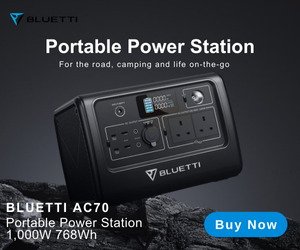In a world driven by technology, staying powered up on the go is more important than ever. Whether you’re camping in the wilderness, traveling abroad, or simply commuting to work, having a reliable source of portable power can be a game-changer. This article dives into the key differences between portable power banks and power stations—two essential gadgets that cater to different power requirements and usage scenarios. By understanding what sets them apart and their respective strengths, you’ll be able to make an informed decision on which one best suits your needs.
Understanding Portable Power Banks and Power Stations:
1. What is a Power Bank?
A power bank is a compact, portable device designed to recharge smaller electronic devices like smartphones, tablets, and Bluetooth headphones. It typically contains lithium-ion batteries and USB ports for charging, making it ideal for short-term power boosts when you’re away from a traditional power source. Power banks come in various capacities measured in milliampere-hours (mAh), ranging from a few thousand mAh to over 20,000 mAh.
- Pros:
- Lightweight and Highly Portable: Power banks are easy to carry around, fitting into pockets or bags, which makes them convenient for travel and outdoor activities.
- Affordable and Widely Available: They are cost-effective and readily accessible, available in various capacities and designs to suit different needs.
- Quick and Easy to Use: Simply plug in your device via USB cable to start charging, providing immediate power when needed, especially useful in emergencies or on-the-go situations.
- Cons:
- Limited Capacity: Compared to portable power stations, power banks have a lower capacity, typically suitable for charging smaller devices only.
- Mainly for Small Devices: They are primarily designed for smartphones, tablets, and similar gadgets, lacking the power output needed for larger appliances or extended use.
2. What is a Portable Power Station?
A portable power station is a larger, more robust device that functions as a portable generator, capable of powering not just phones but also laptops, mini-fridges, and even medical devices. It integrates advanced batteries and multiple output ports (AC, DC, USB) to provide a wider range of power options for longer durations. Typically measured in watt-hours (Wh), ranging from 100Wh to several thousand Wh, depending on the model,.
- Pros:
- Versatile and Can Power Various Devices: Portable power stations are designed to handle multiple electronic devices simultaneously, from smartphones to larger appliances like mini-fridges and even medical equipment.
- Higher Capacity and Longer Lasting: Compared to power banks, they offer higher capacity and longer-lasting power, making them suitable for extended use in outdoor activities, emergency backup situations, and off-grid living.
- Suitable for Various Applications: Ideal for camping trips, outdoor events, emergency preparedness, and remote work where access to traditional power sources may be limited.
- Cons:
- Bulkier and Heavier: Due to their larger capacity and robust build, portable power stations are bulkier and heavier than power banks, which may affect portability.
- Higher Cost: They tend to be more expensive than power banks, primarily due to the advanced battery technology and additional features they incorporate.
Top Picks: Best Power Banks and Portable Power Stations
Best Power Banks:
Anker PowerCore 26800mAh
- Capacity: 26800mAh, Output Ports: 3 USB ports
The Anker PowerCore 26800mAh is renowned for its high-speed charging capabilities, thanks to PowerIQ and VoltageBoost technologies. These technologies enable efficient and rapid charging of multiple devices simultaneously, making it an ideal choice for users who require reliable and quick power solutions on the go.
RAVPower 20000mAh Portable Charger
- Capacity: 20000mAh, Output Ports: 2 USB ports
The RAVPower 20000mAh Portable Charger features a compact design and incorporates Quick Charge 3.0 technology, ensuring faster charging speeds for compatible devices. It includes LED indicator lights that provide convenient battery level monitoring, allowing users to stay informed about remaining power levels at a glance.
Samsung 10000mAh Wireless Power Bank
- Capacity: 10000mAh, Output Ports: 1 USB-C port, 1 USB-A port, Wireless charging pad
The Samsung 10000mAh Wireless Power Bank offers versatile charging options, including a USB-C port, a USB-A port, and a wireless charging pad that supports Qi-compatible devices. Its slim and portable design makes it convenient for travel and everyday use, while its fast charging capabilities ensure quick and efficient power delivery.
Best Portable Power Stations:
BLUETTI EB3A Portable Power Station
- Capacity: 268Wh, Output Ports: AC, DC, USB ports
The BLUETTI EB3A is noted for its compact design and impressive power output capability of 600W. This makes it highly versatile, capable of powering a wide range of electronics and appliances while on the go. Whether you’re camping, traveling, or preparing for emergencies, its combination of portability and robust power output makes it a reliable choice.
ECOFLOW River Max 2 Portable Power Station
- Capacity: 576Wh, Output Ports: AC, DC, USB ports
Known for its rapid recharge capability, the ECOFLOW River Max 2 can efficiently power a diverse range of devices, from drones to mini-fridges and CPAP machines. Its robust design and multiple output options make it suitable for both outdoor adventures and emergency backup situations.
Jackery Explorer 300 Portable Power Station
Capacity: 293Wh, Output Ports: AC, DC, USB ports
The Jackery Explorer 300 is known for its quiet operation and does not require fuel, making it environmentally friendly and suitable for outdoor adventures, camping, and emergency backup power. With its multiple output ports, it can charge a variety of devices simultaneously, providing convenience and reliability in remote locations or during power outages.
Choosing Between a Portable Power Banks and a Power Stations:
1. When to Choose a Power Bank:
- Best For:
- Travel and Daily Commutes: For keeping smartphones, tablets, and wearables charged.
- Lightweight and Portable Needs: Ideal for those who prioritize convenience and mobility.
- Short Trips and Day Outings: Provides quick power boosts without the need for extensive charging capabilities.
- Example Use Case: Charging your phone and headphones during a long flight or train journey.
2. When to Choose a Portable Power Station:
- Best For:
- Camping and Outdoor Adventures: Powers larger devices like laptops, mini-fridges, and CPAP machines.
- Emergency Preparedness: Provides reliable backup power during power outages.
- Remote Work and Off-Grid Living: Sustain power for longer durations in places without access to traditional power sources.
- Example Use Case: Running a mini-fridge and charging multiple devices during a camping trip in the wilderness.
Buy the one that aligns with your lifestyle
In conclusion, whether you opt for a portable power station or a power bank depends largely on your specific power needs and usage scenarios. If you’re looking for a compact and lightweight solution to keep your smaller devices charged on the go, a power bank is the way to go. On the other hand, if versatility, capacity, and the ability to power larger devices are essential, investing in a portable power station makes more sense. Ultimately, the choice boils down to assessing how you plan to use your portable power device and ensuring it aligns with your lifestyle and requirements.








